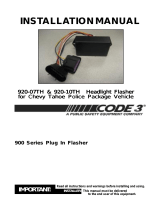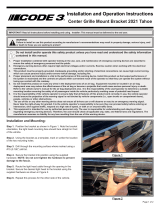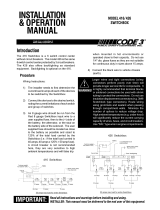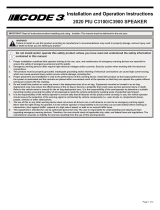
2
Introduction
The Code 3
®
Model 950 and 960 multiple mode flashers are solid state headlight flashers. Both models
can be used as a headlight flasher, non daytime running lights hot side switching flasher or as a light bar
flasher with steady burn override capability. The units allow the user one of three different headlight flasher
patterns. You may use either or all three patterns depending on installation.
Unpacking & Pre-installation
After unpacking your 950 or 960 Multiple Mode Flasher, carefully inspect the unit and associated parts for any
damage that may have been caused in transit. Report any damage to the carrier immediately.
Installation & Mounting
Mounting Methods
The units can be mounted using either the mounting tabs located at each end of the unit or the mounting
hole through the unit.
CAUTION: The unit must be mounted away from heat sources and water splashes.
All devices should be mounted in accordance with the manufacturer's instructions and
securely fasten to vehicle elements of sufficient strength to withstand the forces applied to
the device. Driver and/or passenger air bags (SRS) will affect the way equipment should
be mounted. This device should be mounted by permanent installation and within the
zones specified by the vehicle manufacturer, if any. Any device mounted in the deploy-
ment area of an air bag will damage or reduce the effectiveness of the air bag and may
damage or dislodge the device. Installer must be sure that this device, its mounting
hardware and electrical supply wiring does not interfere with the air bag or the SRS wiring
or sensors. Front or rear grille/bumper placement must avoid interference with SRS
sensors. Mounting the unit inside the vehicle by a method other than the permanent
installation is not recommended as unit may become dislodged during swerving, sudden
braking, or collision. Failure to follow instructions can result in personal injury.
WARNING!
!
The use of this or any warning device does not insure that all drivers can or will observe or
react to an emergency warning signal. Never take the right-of-way for granted. It is your
responsibility to be sure you can proceed safely before entering an intersection, driving
against traffic, responding at a high rate of speed, or walking on or around traffic lanes.
The effectiveness of this warning device is highly dependent upon correct mounting and
wiring. Read and follow the manufacturer’s instructions before installing or using this
device. The vehicle operator should insure daily that all features of the device operate
correctly. In use, the vehicle operator should insure the projection of the warning signal is
not blocked by vehicle components (i.e.: open trunks or compartment doors), people,
vehicles, or other obstructions.
This equipment is intended for use by authorized personnel only. It is the user’s responsi-
bility to understand and obey all laws regarding emergency warning devices. The user
should check all applicable city, state and federal laws and regulations.
Public Safety Equipment, Inc., assumes no liability for any loss resulting from the use of
this warning device.
Proper installation is vital to the performance of this warning device and the safe operation
of the emergency vehicle. It is important to recognize that the operator of the emergency
vehicle is under psychological and physiological stress caused by the emergency situation.
The warning device should be installed in such a manner as to: A) Not reduce the output
performance of the system, B) Place the controls within convenient reach of the operator
so that he can operate the system without losing eye contact with the roadway.
Emergency warning devices often require high electrical voltages and/or currents. Properly
protect and use caution around live electrical connections. Grounding or shorting of
electrical connections can cause high current arcing, which can cause personal injury and/
or severe vehicle damage, including fire. Incandescent lamps are extremely hot, allow to
cool completely before attempting to remove.
Any electronic device may create or be affected by electromagnetic interference. After
installation of any electronic device operate all equipment simultaneously to insure that
operation is free of interference. Never power emergency warning equipment from the
same circuit or share the same grounding circuit with radio communication equipment.
PROPER INSTALLATION COMBINED WITH OPERATOR TRAINING IN THE PROPER
USE OF EMERGENCY WARNING DEVICES IS ESSENTIAL TO INSURE THE SAFETY
OF EMERGENCY PERSONNEL AND THE PUBLIC.
WARNING!
!



















